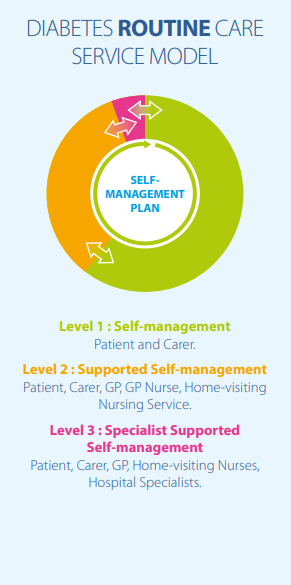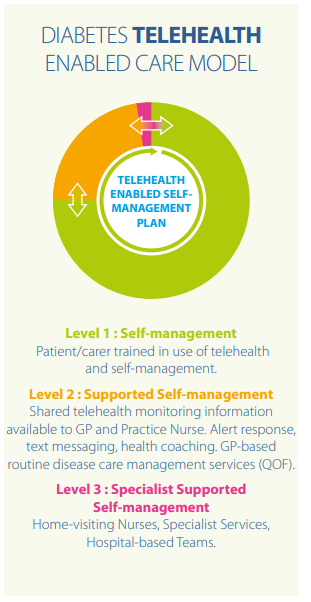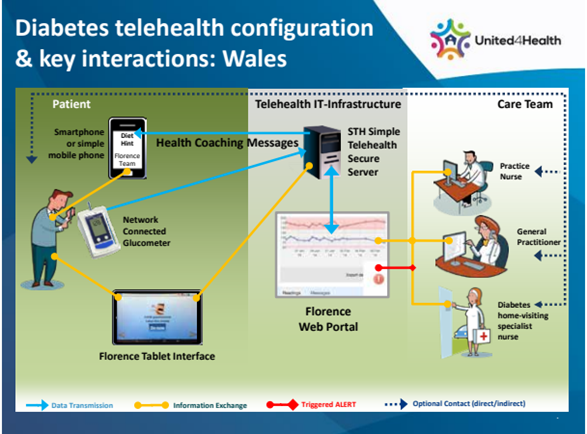Remote Monitoring - Diabetes, Type 2
United4Health(U4H) was a European large scale deployment project that successfully implemented and assessed the impact of innovative healthcare services for the remote monitoring of patients with chronic conditions. The project included 10 countries one of which was Wales. At Hywel Dda University Health Board in West Wales they deployed telemonitoring which focused on managing and supporting patients with diabetes mellitus.
A comparison was made to the Diabetes Routine Care Service Model to the Diabetes Telehealth enabled model.

Diabetes Care Management - routine care
Patients with Type 2 diabetes usually take care of themselves (Green) with support predominantly from their GP and GP practice nurse who has a special interest in diabetes in primary care (Amber).
As a minimum, patients are invited to have annual reviews as part of the Quality and Outcomes Framework (QOF). This includes:
- Testing their HbA1c and renal function
- Measuring their blood pressure and lipids
- Undertaking a microvascular/neuropathic assessment
- Providing them with health and lifestyle advice.
In addition, patients receive a retinopathy screening appointment annually. Patients are able to be referred to medical and nursing diabetes specialists in the hospital and/or community services if required (Pink).

U4H Telehealth Enabled Diabetes Care Management
In comparison the telehealth service has been designed to offer the patient more support via health coaching interventions thereby strengthening self-management (Green) and enhance the routine diabetes care service model delivered by professionals working in primary and home care settings (Amber).
Patients receive automated text message reminders from a system called Florence© (Flo) to perform their blood glucose readings using their own glucometers according to the regime agreed between the patient and their GP practice. The Florence program analyses the patient’s readings according to their individualised parameters agreed between patient and clinical team, and provides instant feedback to the patient via their mobile phone along with locally agreed advice and health coaching messages if required. Should a parameter be critically breached, the patient will be advised on what immediate action to take and who to contact. An alert message is also sent to their nominated diabetes care professional (either Practice Nurse, GP or Home-Visiting Specialist Nurse). This can be reviewed immediately via a secure internet connection, or the next working day if the anomalous parameter occurred out of working hours. The patient continues on low-level telemonitoring for up to 12 months following enrolment. Any worsening symptoms will be treated according to local standard protocols, eg GP appointments with the option of referral to the home-visiting diabetes specialist nurse, emergency room attendance or hospital admission (Pink).
Florence©, Simple Telehealth is a web-based monitoring system (Stoke-on-Trent, NHS England).

Project Aims
- To support individual patients to self-manage and lead a lifestyle to reduce their risk of developing diabetes-related complications though deploying a telehealth enabled care model.
- To procure any necessary technology, integrating it into existing health care services and redesigning pathways as necessary.
- Evaluating different aspects of deployment.
- To offer accessible, equitable and sustainable services to patients.
- To provide an insight into the challenges and opportunities that come from attempting to transform mainstream service delivery.
- Hywel Dda University Health Board

